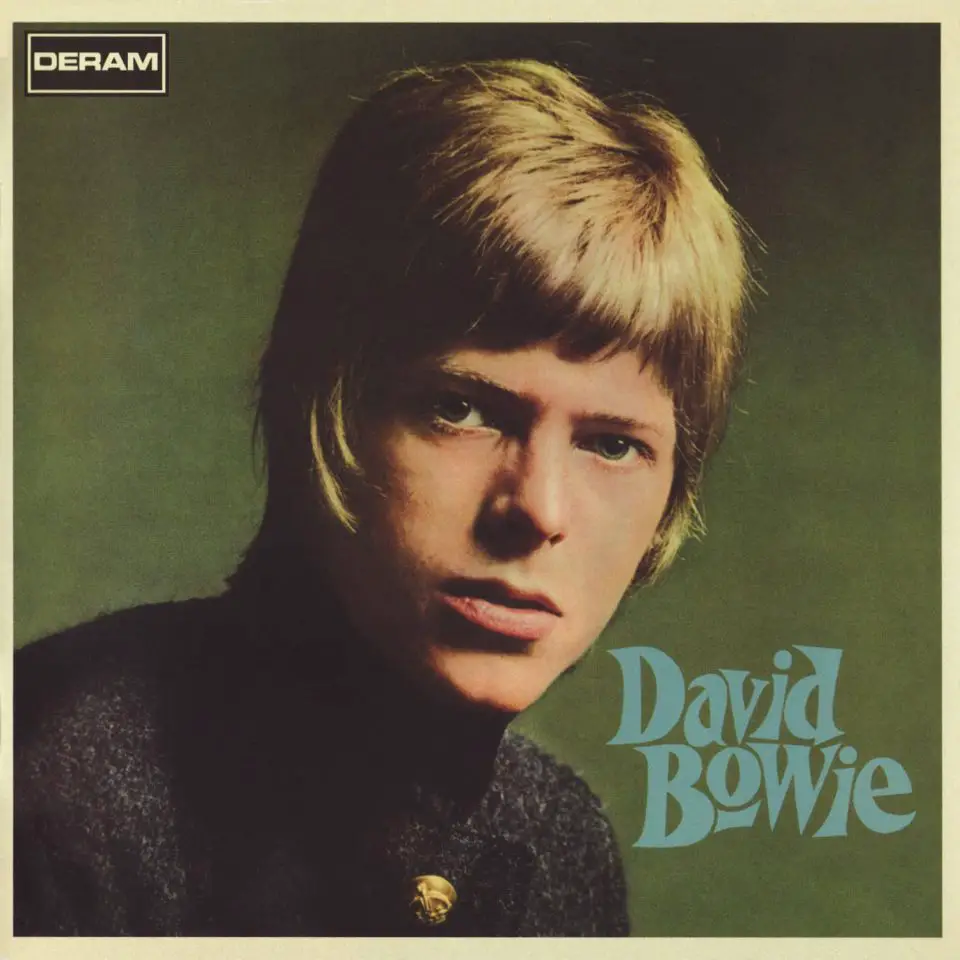Cover artwork
The photograph on the cover of David Bowie’s debut album was taken by Gerald Fearnley, the brother of Bowie’s guitarist Dek Fearnley.The shoot took place in Fearnley’s photography studio in the basement of a church on Bryanston Street near Marble Arch in central London.
I was a still life photographer, working on my own, in a studio right off of Oxford Street. I don’t remember how it happened, but I was enlisted to take photographs of David for the cover. I was probably the only person he knew with a studio and a camera.
For the session Bowie wore an army-style jacket, which was the source of considerable pride for the young singer-songwriter.
As for that cover, that military jacket, I was very proud of that, the first handmade military jacket that I knew of. It was actually tailored.
Q magazine, April 1990
The photo on the album’s rear cover – another portrait of Bowie looking straight into the camera – was taken by David Wedgbury on the Thames embankment near the Decca offices in north London.
The release
Bowie’s record label, Deram, issued two singles ahead of the release of his debut album. The first was ‘Rubber Band’/‘The London Boys’ in December 1966, and ‘The Laughing Gnome’/‘The Gospel According to Tony Day’ in April 1967. The version of ‘Rubber Band’ was different from that on the album.
The David Bowie album was released in separate mono and stereo editions on 1 June 1967, and peaked at number 125 in the album charts.
In the US it was issued on 11 August 1967, without the songs ‘We Are Hungry Men’ and ‘Maid Of Bond Street’. It was similarly a commercial failure.
The albums liner notes were written by Kenneth Pitt:
Although he has rarely strayed far beyond his own suburban London, David Bowie, at 19, has seen more of the world than many people do in a far longer life-time. For David’s keen sense of perception and unusual powers of observation enable him to view the world around him with the eye of an articulate eagle.His line of vision is as straight and sharp as a laser beam. It cuts through hypocrisy, prejudice and cant. It sees the bitterness of humanity, but rarely bitterly. It sees the humour in our failings, the pathos of our virtues. David writes and sings of what he sees to be the truth, and the truth is rarely an ode to the moon and to June. His moon is pock marked and grey. June is not for brides, it is for the birds – if it isn’t raining!
David is very much a product of the fast moving era in which he has spent his teens. An early desire to create took him to art school, but Little Richard discs turned him on to music as a more satisfying art form. At 13 he was playing good enough saxophone to be a credit to his teacher Ronnie Ross. He formed one or two of Britain’s early R&B groups. Then somebody gave him a shove and he was out front singing.
He was immediately impatient with the songs there were to sing and began to write his own. Songs he believed in, songs that were part of him, songs he could sing with feeling. They spilled out all over the place in rapid labour. He moved so fast that everything he did was two years too soon. Why, he was even photographed in 1964 wearing a military jacket!
The world finally grabbed at him as he was rushing by and the result is this recorded collection of Bowiedotes.
Bowie sometimes chose different musicians for the various tracks, but throughout he used the three boys who so ardently believed in his talent that they have loyally supported him during the lean times. They are drummer John Eager, bassist Derek Fearnley and organist Derek Boyes.
Deram released a re-recorded version of ‘Love You Till Tuesday’ as a single in July 1967, though it was not a success, and Bowie was dropped by his label in April 1968. He reworked several of the album’s songs for a 1969 video titled Love You Till Tuesday, which was made as a promotional lure for a new record deal.
Bowie’s debut album, Deram singles and alternative versions have been reissued in a number of guises over the years. A deluxe edition was released in 2010 and contained the mono and stereo mixes, previously unreleased stereo mixes, and Bowie’s first BBC radio session, for the Top Gear show from 18 December 1967.


